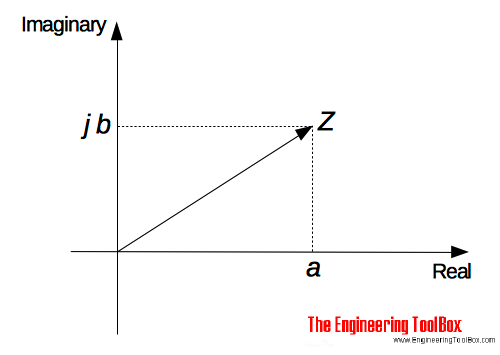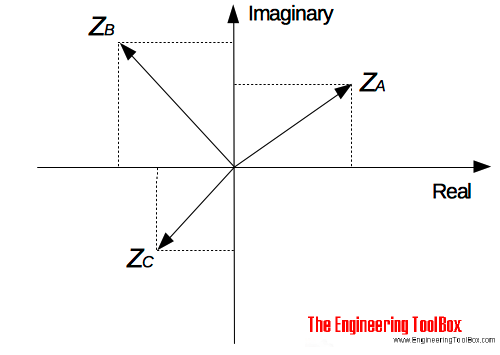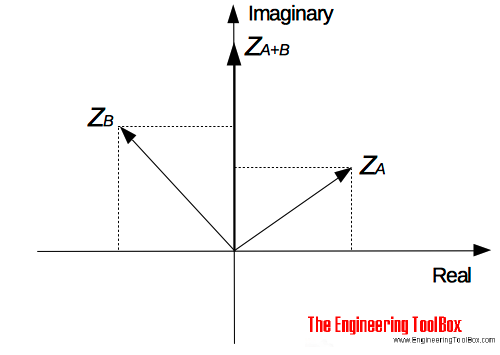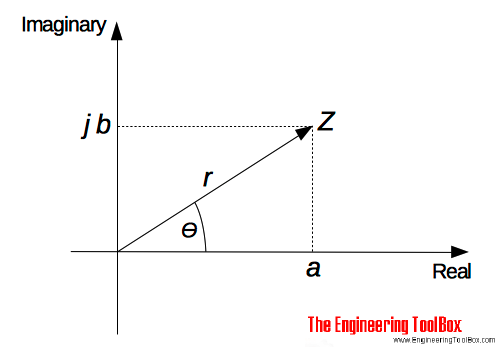Complex Numbers
Complex numbers are used in alternating current theory and mechanical vector analysis.
There are two main forms of complex numbers
- Cartesian
- Polar
Complex numbers on the Cartesian form
A complex number consists of a real part and an imaginary part and can be expressed on the Cartesian form as
Z = a + jb (1)
where
Z = complex number
a = real part
jb = imaginary part (it is common to use i instead of j)
A complex number can be represented in a Cartesian axis diagram with an real and an imaginary axis - also called the Argand diagram:

Example - Complex numbers on the Cartesian form
The complex numbers
ZA = 3 + j2 (2a)
ZB = -3 + j3 (2b)
ZC = -2 - j2 (2c)
can be represented in the Argand diagram:

Addition and Subtraction of Complex numbers
Complex numbers are added/subtracted by adding/subtracting the separately the real parts and the imaginary parts of the number.
Example - Adding two Complex numbers
ZA = 3 + j2
ZB = -3 + j3
Z(A+B) = (3 + (-3)) + (j2 + j3)
= j5

Complex numbers on the Polar form
A complex number on the polar form can be expressed as
Z = r (cos(θ) + jsin(θ)) (3)
where
r = modulus (or magnitude) of Z - and is written as "mod Z" or |Z|
θ = argument (or amplitude) of Z - and is written as "arg Z"

r can be determined using Pythagoras' theorem
r = (a2 + b2)1/2 (4)
θ can be determined by trigonometry
θ = tan-1(b / a) (5)
(3) can also be expressed as
Z = r ejθ (6)
As we can se from (1), (3) and (6) - a complex number can be written in three different ways.
Example - Complex number on the Polar form
The complex number
Za = 3 + j2
can be expressed on the polar form by calculating the modulus and the argument.
The "modulus" can be calculated by using eq. (4):
r = (32 + 22)1/2
= 3.606
The "argument" can be calculated by using eq. (5):
θ = tan-1(2 / 3)
= 33.69o
The complex number on polar form (3):
Za = 3.606 (cos (33.69) + j sin( 33.69))
Or alternatively (6)
Za = 3.606 ej 33.69
Adding or Subtraction of Complex Numbers
Adding Complex Numbers
Za = a + jb
Zb = c + jd
Za + Zb = (a + jb) + (c + jd)
= (a + c) + j(b + d) (6)
or alternative
Za = ra (cos(θa) + jsin(θa))
Zb = rb (cos(θb) + jsin(θb))
Za + Zb = ra (cos(θa) + jsin(θa) + rb (cos(θb) + jsin(θb))
= (ra cos(θa) + rb cos(θb)) + j(ra sin(θa) + rb sin(θb)) (6b)
or alternatively
Za = ra ejθa
Zb = rb ejθb
Za + Zb = ra ejθa + rb ejθb
= (ra cos(θa) + rb cos(θb)) + j(ra sin(θa) + rb sin(θb)) (6c)
Example - Adding Complex Numbers
Za = 3 + j2
Zb = 5 - j4
Za + Zb = (3 + j2) + (5 - j4)
= (3 + 5) + j(2 + (-4))
= 8 - j2
Example - Adding Complex Numbers
Za = 3 (cos(35) + jsin(35))
Zb = 2 (cos(15) + jsin(15))
Za + Zb = (3 cos(35)+ 2 cos(15)) + j(3 sin(35) + 2 sin(15))
= 4.38 - j2.2
Subtracting Complex Numbers
Za = a + jb
Zb = c + jd
Za - Zb = (a + jb) - (c + jd)
= (a - c) + j(b - d) (7)
Example - Subtracting Complex Numbers
Za = 3 (cos(35) + jsin(35))
Zb = 2 (cos(15) + jsin(15))
Za - Zb = 3 (cos(35) + jsin(35)) - 2 (cos(15) + jsin(15))
= (3 cos(35) - 2 cos(15)) + j(3 sin(35) - 2 sin(15))
= 0.52 + j1.2
Multiplication of Complex Numbers
Za = a + jb
Zb = c + jd
Za Zb = (a + jb) (c + jd)
= a c + a (jd) + (jb) c + (jb) (jd)
= a c + j(a d) + j(b c) + j2(b d) (8)
Since j2 = -1 - (8) can be transformed to
Za Zb = (a + jb) (c + jd)
= (a c - b d) + j(a d + b c) (8b)
Example - Multiplying Complex Numbers
Za = 3 + j2
Zb = 5 - j4
Za Zb = (3 + j2) (5 - j4)
= (3 5 - 2 (-4)) + j(3 (-4) + 2 5)
= 23 - j2
Complex Conjugate
The complex conjugate of (a + jb) is (a - jb).
Multiplying a complex number with its complex conjugate results in a real number like
Za = a + jb
Za* = a - jb
Za Za* = (a + jb) (a - jb)
= a2 - j(a b) + j(a b) - j2b2
= a2 - (- b2)
= a2 + b2 (9)
Example - Multiplying a Complex Number with its Conjugate
Za = 3 + j2
Za* = 3 - j2
Za Za* = (3 + j2) (3 - j2)
= 32 + 22
= 13
Division of Complex Numbers
Division of complex numbers can be done with the help of the denominators conjugate:
Za = a + jb
Zb = c + jd
Za / Zb = (a + jb) / (c + jd)
= ((a + jb) / (c + jd)) ((c - jd) / (c - jd))
= (a c + j(a d) + j(b c) + j2(b d)) / (c2 + d2) (10)
Multiplying both the nominator and the denominator with the conjugate of the denominator is called rationalizing.



